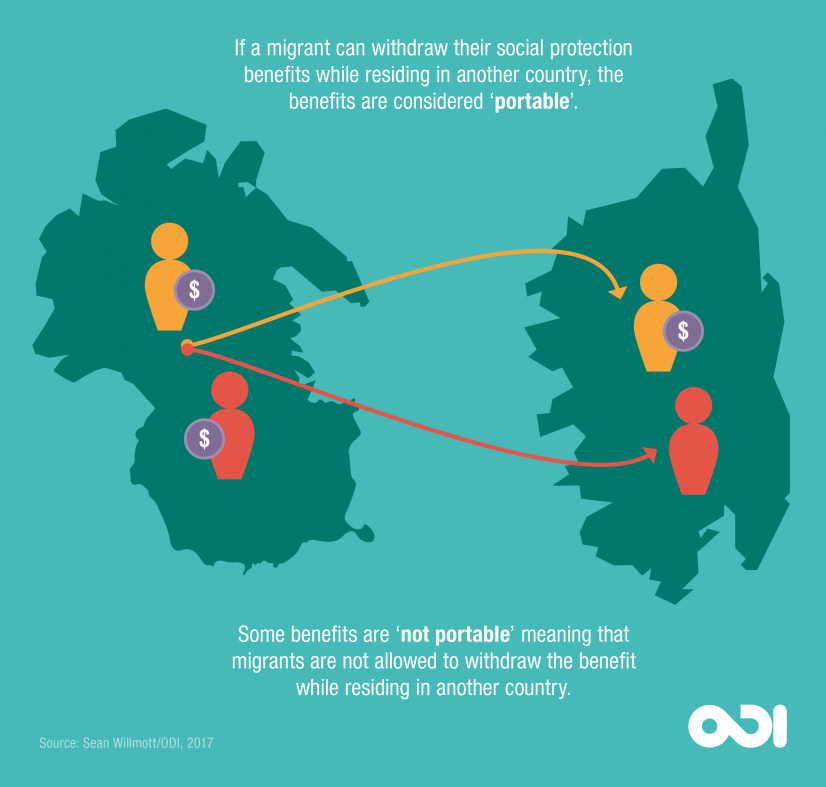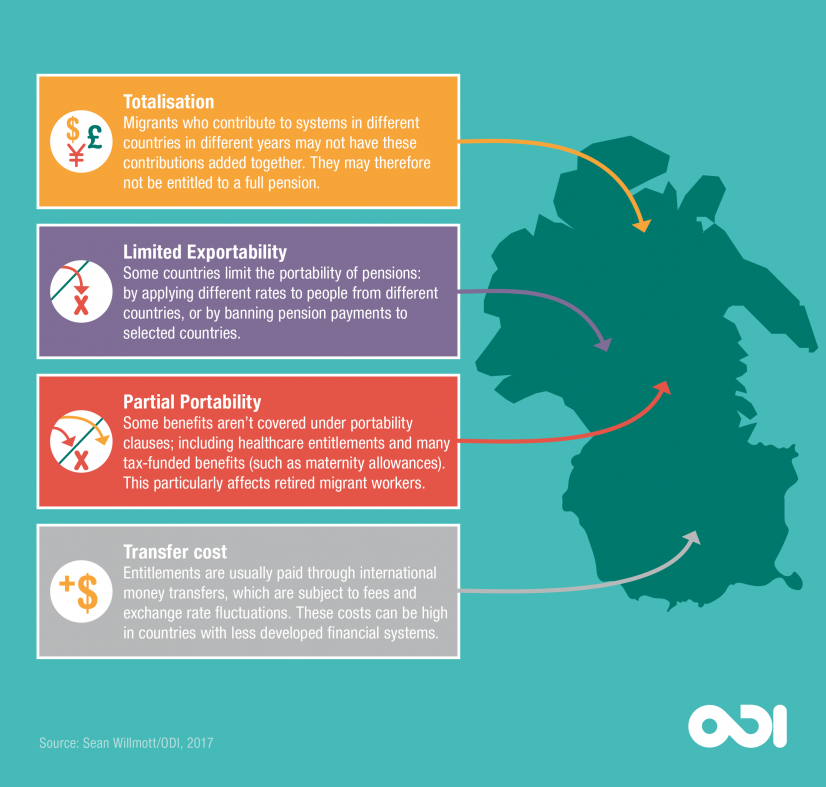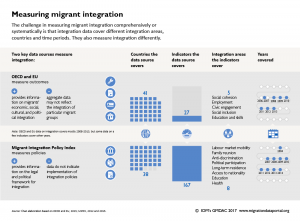On March 26, the revised draft of the Global Compact on Migration (GCM) was released. To achieve its goal of “safe, orderly and regular migration”, it proposes 22 actionable commitments, covering different areas, sectors and levels of action along the migration cycle. Most commitments have an obvious and concrete link to migration and mobility, but number 22 is more cryptic: “Establish mechanisms for the portability of social security entitlements and earned benefits”. What does this mean, and why does it matter?
Furthermore, to fulfill GCM commitment 22, what steps need to be taken, particularly in terms of data collection and analysis on social security entitlements and earned benefits?
What does the portability of entitlements and benefits mean?
Both social security entitlements and earned benefits come under the term social protection: the policies and programmes that aim to reduce poverty and vulnerability to shocks. It includes:
- Social assistance such as cash transfers to poor households. These are not conditional on having previously made contributions and are often funded from general taxation; and
- Social security / insurance such as pensions. These are conditional on past contributions by employees and employers.
Where migration comes in is around access. Last year, we at the Overseas Development Institute (ODI) looked into these links between social protection and migration. We found that some programmes grant regular migrants working in the informal economy eligibility to these programmes in their host countries; others don’t. Even if a migrant is legally eligible to contribute to and receive benefits in their host country, they may not be able to take the money they’ve accrued back to their home country. This is the essence of “portability”: if benefits can be withdrawn in another country, they are portable, if not (or only partially), they are non-portable (see Figure 1). Even if benefits are in principle portable, to do so may incur high transfer fees, or the transfer may be blocked to certain countries.
Figure 1: Explaining the portability of benefits
Why does portability matter?
Firstly, fairness. Migrants deserve to draw on the benefits they contributed towards. Secondly, incentives. Non-portability reduces migrants’ incentives to contribute to social security systems, and increases incentives to work in the informal economy, with negative effects for host countries and migrants themselves. It also reduces the incentives for regular migration. Finally, mobility. Non-portability makes circular migration less attractive and could reduce return migration, potentially depriving origin countries – many of them developing – of the beneficial development effects of migration.
What do we know about portability?
We know little on the specifics of portability because data on social protection coverage of migrants are hard to come by. When data are available, they only tend to cover certain types of agreements or parts of the world. For example, the database of the International Social Security Association (ISSA) only considers bilateral agreements. Likewise, the United States (US) Social Security Administration only provides an overview of agreements between the US and other countries.
There are, however, many agreements which set out the social protection rights of migrants in host countries. Some are bilateral, including between countries in the global North. Certain European Union (EU) countries have agreements with Turkey and Morocco, allowing labour migrants’ contributions into national social insurance schemes across a number of different countries to be added together. Others are multilateral, providing frameworks for coordinating portability at the regional level. For instance, the Caribbean Community (CARICOM) allows social security contributions to accumulate across member states, helping labour migrants to meet state-pension contribution thresholds.
Despite these agreements, many such benefits are not portable (see common issues in Figure 2). Some countries limit the portability of pensions by applying different rates to people from different countries, or by banning pension payments to selected countries. For example, Germany and the UK apply reduction rates to pension payments for nationals of countries with which they have no social security agreement, and the US bans pension payments to selected countries.
Figure 2: The most common portability constraints
What do we need to do? Four key recommendations
To increase social protection portability for migrants, we need to:
- Collect more data on migration. For instance, irregular migrants are usually missing from official population statistics, and migrants in general are not always clearly identified in either data or legislation. Instead, eligibility for social protection tends to be based on residence status or nationality. This lack of data on migration more generally exacerbates the ineffectiveness of social protection arrangements. Having data on migrants, their vulnerabilities and needs would allow for better social protection programming for migrants. For instance, it could be used to target migrants who may in fact already be eligible for social protection or to create outreach programmes for groups who are hard to reach through regular channels.
- Collect more data on the social protection coverage of migrants. National data on social protection programmes should disaggregate by citizenship and residence status (a strong proxy for migrant status). This would help estimate effective, or de facto, social protection coverage of labour migrants, and manage the financial implications of benefits becoming portable. This could build on the work of the ISSA and ILO.
- Continue to negotiate bilateral and multilateral social security agreements, extending portability practices to more countries. Focus on South-South migration corridors and developing countries, many of which do have some social security programming in place, but little in terms of portability arrangements. Encourage timely ratification of these agreements to ensure they are operational as soon as possible.
- Lift any restrictions on existing portability arrangements by origin countries. This includes enabling the transfer of benefits to all countries and ending the practice of applying reduction rates to entitlement transfers to certain countries.
There are strong reasons for including a commitment to portability of benefits in the Global Compact for Migration. Given the substantial links between portability and incentives for regular migration, and mobility more generally, keeping this commitment in is a no-brainer, and better data could help us in delivering it.








